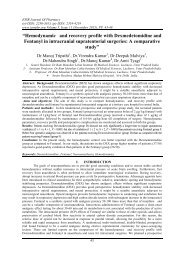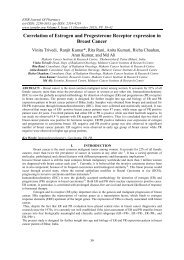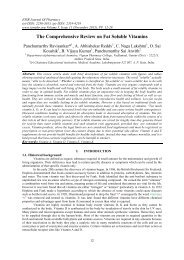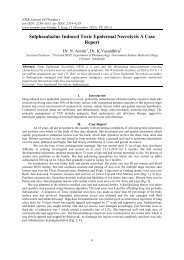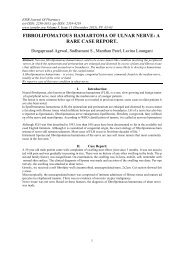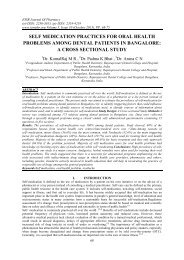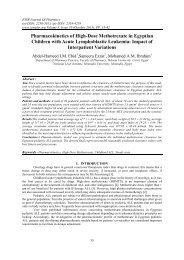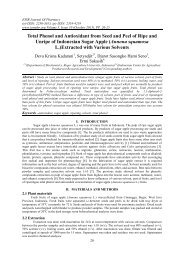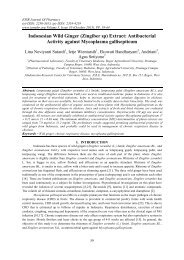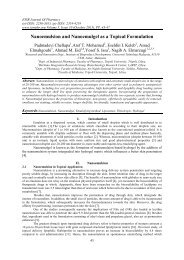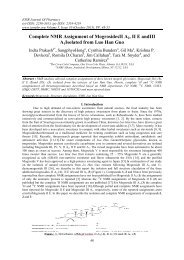Clinical manifestations, diagnosis,and treatment of Melioidosis
Create successful ePaper yourself
Turn your PDF publications into a flip-book with our unique Google optimized e-Paper software.
16<br />
<strong>Clinical</strong> <strong>manifestations</strong>, <strong>diagnosis</strong>…<br />
with fevers, weight loss,productive cough (sometimes with hemoptysis),<strong>and</strong> classic upper lobe infiltrates, with<br />
or without cavitation on chest radiographs. In these patients, disease can be remitting <strong>and</strong> relapsing over many<br />
years, sometimes with a mis<strong>diagnosis</strong> <strong>of</strong> tuberculosis. Although acute deterioration with septicemia may occur,<br />
mortality in this group is low [41].<br />
Until recently it was thought that a colonization state did not exist for B.pseudomallei,with presence in<br />
sputum or throat always reflecting disease.However,it has recently become evident that B.pseudomallei can both<br />
colonize always <strong>and</strong> cause disease in patients with cystic fibrosis(CF) <strong>and</strong> bronchiectasis. The similarity to<br />
infection with B.cepecia complex in CF is <strong>of</strong> concern, given the association <strong>of</strong> B.cepecia complex with more<br />
rapid deterioration in lung function.Furthermore, likely transmission <strong>of</strong> B.pseudomallei between two siblings<br />
with CF has been reported[41,72]. Patients with CF traveling to melioidosis-endemic locations should be<br />
warned <strong>of</strong> the risk <strong>of</strong> melioidosis, which could be considered if they become sick after returning [41].<br />
It is common for patients to present with skin ulcers or abscesses [73].Occasionally they present with septic<br />
arthritis or osteomyelitis, or one <strong>of</strong> these can develop after the patient has presented with another primary<br />
<strong>diagnosis</strong>, usually pneumonia.Also well recognized, whatever the clinical presentation, are diseases in internal<br />
organs, especially in spleen, kidney, prostrate <strong>and</strong> liver.Where available, abdominopelvic computed tomography<br />
(CT) scanning is useful in all melioidosis patients to detect internal abscesses[41].<br />
These have been noted between Thail<strong>and</strong> <strong>and</strong> tropical Australia. First, suppurative parotitis accounts for up to<br />
40% <strong>of</strong> melioidosis in children in Thail<strong>and</strong> [68, 74],but is very rare in Australia.Second, prostrate melioidosis is<br />
well recognized but uncommon, except in Australia, where routine abdominopelvic CT scanning <strong>of</strong> all<br />
melioidosis cases has shown prostrate abscesses present in 18% <strong>of</strong> all male patients with melioidosis[66].Some<br />
were incidental in patients presenting with pneumonia or septicemia, but a primary genitourinary presentation<br />
was common with fever, abdominal discomfort, dysuria, <strong>and</strong> sometimes diarrhea <strong>and</strong> urinary retention.Third<br />
neurological melioidosis accounts for 4% <strong>of</strong> cases in northern Australia, with distinctive clinical features being<br />
brain stem encephalitis, <strong>of</strong>ten with cranial nerve palsies(especially the seventh nerve),together with peripheral<br />
motor nerve),together with peripheral motor weakness, or occasionally just flaccid paraparesis alone.The CT<br />
scan is <strong>of</strong>ten normal, but dramatic changes are seen on magnetic resonance imaging(MRI),most notably a<br />
diffusely increased T2-weighed signal in midbrain, brain stem, <strong>and</strong> spinal cord[41,75].Direct bacterial invasion<br />
<strong>of</strong> the brain <strong>and</strong> spinal cord occurs with melioidosis encephalomyelitis[41,76].<br />
Neurological melioidosis is occasionally seen outside Australia, although mostly macroscopicbrain abscesses<br />
[41, 22, 77].Unusual foci <strong>of</strong> melioidosis infection described in case reports or case series include mycolic<br />
aneurysms, lymphadenitis resembling tuberculosis, mediastinal masses, pericardial collections, <strong>and</strong> abnormal<br />
abscesses.<br />
It has long been recognized that B.pseudomallei,like tuberculosis, has the potential for reactivation<br />
from a latent focus, usually in the lung-hence the concern <strong>of</strong> the ―Vietnamese time bomb‖ in returned soldiers.<br />
Latent periods from exposure to B.pseudomallei in an endemic region to onset <strong>of</strong> melioidosis in a nonendemic<br />
region have been documented as long as 62 years [78].However, cases <strong>of</strong> reactivation B.pseudomallei appear to<br />
be very uncommon, accounting for only 3% <strong>of</strong> cases in northern Australia.The vast majority <strong>of</strong> cases <strong>of</strong><br />
melioidosis occur in the monsoonal wet seasons <strong>of</strong> various endemic regions, supporting the concept that<br />
endemic areas most patients with melioidosis have recent infections that appear with acute illness.Reactivation<br />
<strong>of</strong> melioidosis has been associated with influenza, other bacterial sepsis, <strong>and</strong> development <strong>of</strong> known melioidosis<br />
risk factors such as diabetes. It remains unknown what proportion <strong>of</strong> asymptomatic seropositive people actually<br />
have latent infection with potential for reactivation [41].<br />
V.DIAGNOSIS<br />
There are no reliable pathognomonic features <strong>of</strong> acute or sub-acute melioidosis.Other infections<br />
including tuberculosis <strong>and</strong> typhoid fever are commonly confused with melioidosis. The commonest clinical<br />
presentation <strong>of</strong> the disease in northern Australia <strong>and</strong> Southeast Asia where the infection appears to be<br />
commonest is septicemia with or without pneumonia[75].The majority <strong>of</strong> severe infections occur in patients<br />
with contributory co-morbidity such as uncontrolled diabetes mellitus, chronic renal failure,alcoholic liver<br />
disease or chronic lung disease [42].A history <strong>of</strong> contact with soil, water <strong>and</strong> percutaneous inoculation is also a<br />
risk factor <strong>of</strong> melioidosis[7].<br />
A definitive <strong>diagnosis</strong> <strong>of</strong> melioidosis requires a positive culture <strong>of</strong> B.pseudomallei. <strong>Melioidosis</strong> must be<br />
considered in a febrile patient in or returning from endemic regions to enable appropriate samples to be<br />
tested.B.pseudomallei readily grows in commercially available blood culture media,but it is not unusual for<br />
laboratorities in nonendemic locations to misidentify the bacteria as Pseudomonas species,especially because<br />
some commercial indectification syatems are poor at identifying B.pesudomalli[[79]..<br />
Culture from nonsterile sites increases the likelihood <strong>of</strong> <strong>diagnosis</strong> but can be problematic. The rate <strong>of</strong> successful<br />
culture is increased if sputum, throat swabs, ulcer or skin lesion swabs, <strong>and</strong> rectal swabs are placed into<br />
Ashdown’s medium, a gentamicin-containing liquid transport broth that results in the selective growth <strong>of</strong>




